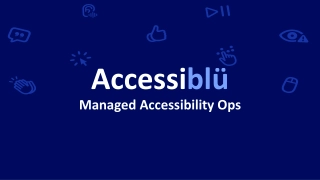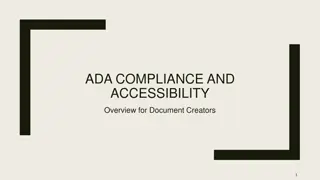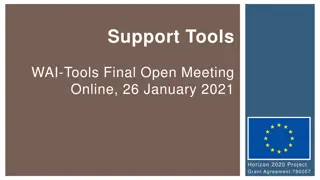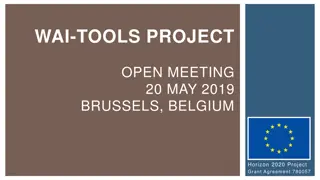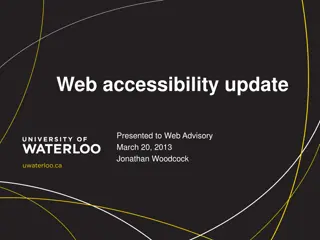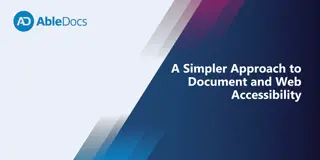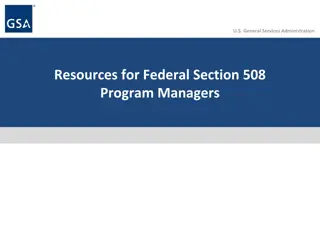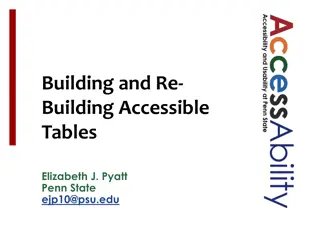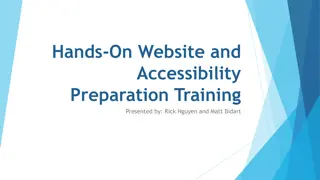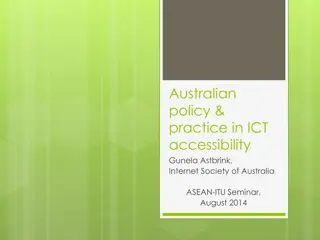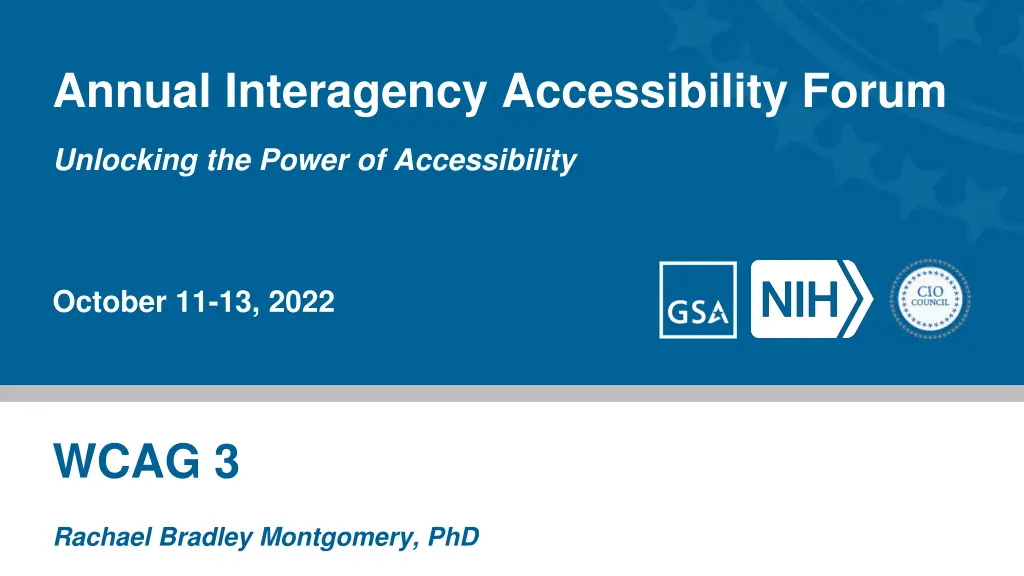
Evolving Accessibility Standards in Technology
Explore the evolution of accessibility standards in technology, uncovering the reasons behind their development and the limitations of previous standards. Dive into the journey from WCAG 2.x constraints to the upcoming WCAG 3, led by experts like Dr. Rachael Bradley Montgomery. Discover the timeline of advancements, from the Silver Taskforce beginnings to the finalized approaches in 2024, aiming to unlock the power of accessibility for all users.
Download Presentation

Please find below an Image/Link to download the presentation.
The content on the website is provided AS IS for your information and personal use only. It may not be sold, licensed, or shared on other websites without obtaining consent from the author. If you encounter any issues during the download, it is possible that the publisher has removed the file from their server.
You are allowed to download the files provided on this website for personal or commercial use, subject to the condition that they are used lawfully. All files are the property of their respective owners.
The content on the website is provided AS IS for your information and personal use only. It may not be sold, licensed, or shared on other websites without obtaining consent from the author.
E N D
Presentation Transcript
Click to edit Master title style Annual Interagency Accessibility Forum Unlocking the Power of Accessibility Click to edit Subtitle October 11-13, 2022 WCAG 3 Rachael Bradley Montgomery, PhD
Speaker: Rachael Bradley Montgomery, PhD Digital accessibility architect at the Library of Congress Co-chair of the W3C Accessibility Guidelines Working Group Executive director of Accessible Community Adjunct lecturer at University of Maryland s College of Information Studies (iSchool) Affiliate faculty with the Trace Research and Development Center This talk represents my personal opinions IAAF 2022 / General Services Administration / National Institutes of Health / Federal CIO Council 2
Background IAAF 2022 / General Services Administration / National Institutes of Health / Federal CIO Council 3
Why do standards evolve? Standards evolve because they do not fully meet the needs they were written to address Technology changes Mobile, touch screens, augmented reality, virtual reality The need was not met fully in the first place We learn how to write a better standard IAAF 2022 / General Services Administration / National Institutes of Health / Federal CIO Council
WCAG 2.x has constraints Testing occurs at the component or view level Limited concepts of user process and Set of webpages No ability to test based on context (Example English vs. Hebrew) Backward compatibility Anything that benefits everyone is not considered for a standard An accessibility standard must disproportionately favor individuals with a disability Limitation: Everyone knows it when they see it but can t test it within the 2.x framework IAAF 2022 / General Services Administration / National Institutes of Health / Federal CIO Council
Timeline Late 2016/Early 2017: Silver Taskforce and Community Group Started 2017-2021 Research Architecture Design Requirements Conformance Prototypes Writing Process First Public Working Draft Published January 2021 2021-2022 Revising approach based on feedback on draft 2024 Final approach to architecture, content, and conformance and schedule for completion 6 IAAF 2022 / General Services Administration / National Institutes of Health / Federal CIO Council
Requirements (1 of 3) 1. Multiple ways to measure All WCAG 3.0 guidance has tests or procedures so that the results can be verified. In addition to the current true/false success criteria, other ways of measuring (for example, rubrics, sliding scale, task-completion, user research with people with disabilities, and more) can be used where appropriate so that more needs of people with disabilities can be included. 2. Flexible maintenance and extensibility Create a maintenance and extensibility model for guidelines that can better meet the needs of people with disabilities using emerging technologies and interactions. The process of developing the guidance includes experts in the technology. 3. Multiple ways to display Make the guidelines available in different accessible and usable ways or formats so the guidance can be customized by and for different audiences. 7 IAAF 2022 / General Services Administration / National Institutes of Health / Federal CIO Council
Requirements (2 of 3) 4. Technology Neutral Guidance should be expressed in generic terms so that they may apply to more than one platform or technology. The intent of technology-neutral wording is to provide the opportunity to apply the core guidelines to current and emerging technology, even if specific technical advice doesn't yet exist. 5. Readability/Usability The core guidelines are understandable by a non-technical audience. Text and presentation are usable and understandable through the use of plain language, structure, and design. 6. Regulatory Environment The Guidelines provide broad support, including: Structure, methodology, and content that facilitates adoption into law, regulation, or policy, and Clear intent and transparency as to purpose and goals, to assist when there are questions or controversy. 8 IAAF 2022 / General Services Administration / National Institutes of Health / Federal CIO Council
Requirements (3 of 3) 7. Motivation The Guidelines motivate organizations to go beyond minimal accessibility requirements by providing a scoring system that rewards organizations which demonstrate a greater effort to improve accessibility. 8. Scope The guidelines provide guidance for people and organizations that produce digital assets and technology of varying size and complexity. This includes large, dynamic, and complex websites. Our intent is to provide guidance for a diverse group of stakeholders including content creators, browsers, authoring tools, assistive technologies, and more. 9 IAAF 2022 / General Services Administration / National Institutes of Health / Federal CIO Council
How to Give Feedback IAAF 2022 / General Services Administration / National Institutes of Health / Federal CIO Council 10
Editors vs. Working drafts The Working Draft is the draft used to request comment from the public The Editor s Draft is the draft used for content that is still being worked Historically, there has been confusion about how final content is within each of these drafts 1 1 IAAF 2022 / General Services Administration / National Institutes of Health / Federal CIO Council
Maturity Levels 1. Placeholder As we through each step, the content becomes Increasingly detailed and definite 2. Exploratory 3. Developing 4. Refining 5. Mature IAAF 2022 / General Services Administration / National Institutes of Health / Federal CIO Council 12
Placeholder What it means: AG has identified we need content but do not yet know what it should look like Goal: Identify needs and possible directions, Ensure content phrasing is appropriate to placeholder stage Likelihood to change: Definite Feedback Needed: No feedback is needed on placeholder content. Location: Editor s Draft Editor s note: Optional 13 IAAF 2022 / General Services Administration / National Institutes of Health / Federal CIO Council
Exploratory What it means: AG is exploring one or more possible directions for this content Goal: Document direction(s) Likelihood to change: Very likely Feedback needed: Feedback should be about the proposed direction Location: Editor s Draft Editor s note: All outstanding questions, concerns, possible directions, etc. Include link to outstanding issues. Most content from the First Public Working Draft, including the example guidelines, is Exploratory IAAF 2022 / General Services Administration / National Institutes of Health / Federal CIO Council 14
Developing What it means: AG has high confidence in the direction and some confidence in the details Goal: Work out details and address open questions Likelihood to change: Details likely to change, overall direction unlikely to change Feedback needed: Feedback should be focused on ensuring the sections are usable and reasonable in a broad sens. Location: Editor s Draft in the beginning, Working draft as it progresses Editor s note: Questions that need broader feedback and details that still need work. IAAF 2022 / General Services Administration / National Institutes of Health / Federal CIO Council 15
Refining What it means: AG has high confidence in the direction and moderate confidence in the details Goal: Get wide stakeholder feedback Likelihood to change: Details may change, overall direction unlikely to change Feedback needed: Feedback should be focused on the feasibility and implementability Location: Editors and Working Draft Editor s note: Questions that need broader feedback and details that still need work. IAAF 2022 / General Services Administration / National Institutes of Health / Federal CIO Council 16
Mature What it means: AG believes the content is \ready to become a W3C Recommendation Goal: Refine and finalize Likelihood to change: Unlikely to change Feedback needed: Feedback should be focused on edge case scenarios the working group may not have anticipated Location: Editors and Working Draft Editor s note: Usually none 17 IAAF 2022 / General Services Administration / National Institutes of Health / Federal CIO Council
Ways to give feedback File an issue in the W3C silver GitHub repository https://github.com/w3c/silver/issues/new Send email to public-agwg-comments@w3.org Please file one issue or send one email per change 18 IAAF 2022 / General Services Administration / National Institutes of Health / Federal CIO Council
Direction we are Exploring (Content after this is not final) IAAF 2022 / General Services Administration / National Institutes of Health / Federal CIO Council 19
Framework for Accessible Specification of Technologies (FAST) Editor s DRAFT FAST Editor s Draft: https://w3c.github.io/fast/ - Not yet at working draft level Expanded Functional Performance Criteria 2.3 Physical 2.3.4 Speech 2.3.4.1 Use without vocalization 2.3.4.2 Use with limited vocalization or volume User Needs Breakdown 3.2 Operable 3.2.2 Allow adjustable content 3.2.2.1 Users can adjust duration requirements 3.2.2.2 Users can adjust content orientation 3.2.2.3 Users can adjust orientation in space IAAF 2022 / General Services Administration / National Institutes of Health / Federal CIO Council 20
Structure for the WCAG 3.0 Guidelines: High-level, plain-language version of the content for managers, policy makers, individuals who are new to accessibility How-To sections describe the guideline Outcomes: Testable statements Technology neutral All outcomes must be met to support a guideline. ( and between outcomes) Methods: Detailed information on how to meet the outcome Technology specific Each method fully meets the outcome ( or between methods ) Includes code samples, working examples, resources Guidelines How Tos Outcomes Methods Descriptions Examples Test Sets IAAF 2022 / General Services Administration / National Institutes of Health / Federal CIO Council 21
Two types of tests (Exploratory) Computational: Tests where results will not vary based on the tester or approach. Examples include testing whether certain properties exist in the content or if they match a value specified by the requirement. Qualitative: Tests that rely on a qualitative evaluation based on existing criteria. Test results may vary between testers who understand the criteria. Examples include evaluating the quality and applicability of certain properties of the content. IAAF 2022 / General Services Administration / National Institutes of Health / Federal CIO Council 22
Four possible types of methods (Exploratory) Prescriptive requirements: How to conform, and how to test for conformance is predetermined. If there is more than one option, all options are defined by the standard. Adaptive requirements: The testing process includes variations where the results rely on the external and/or user-specific context in which content is being tested. The tests are still computational or qualitative tests but the context dictates what results are expected, and which tests are relevant. Extensible requirements: Requirements that rely on selecting from multiple valid ways to measure the outcome (for example, there are multiple accepted specifications for measuring luminance, and the testers will need to determine which is most valid for their use case). Protocol-based requirements: Using accepted industry protocols that meet defined quality criteria (examples include Usability and Plain Language protocols) to improve accessibility. IAAF 2022 / General Services Administration / National Institutes of Health / Federal CIO Council 23
Example methods: Images have text alternatives (Exploratory) Computational Qualitative Image has non-empty accessible name Image is decorative Image has text alternative Text alternative is sufficient replacement for image? Prescriptive Accessible name meets style guide requirement Accessible name is appropriate for the human language Adaptive Text alternative is sufficient replacement for image? Not applicable Not applicable Extensible Image alt text follows guidance for ecommerce image descriptions Image alt text follows plain language protocol Procedural IAAF 2022 / General Services Administration / National Institutes of Health / Federal CIO Council 24
Example methods: Text contrast (Exploratory) Computational Qualitative Text has minimum contrast Not applicable Prescriptive Not applicable Adaptive For an interface that has 3 contrast modes (high contrast, normal, and low contrast), to meet contrast requirements: 1. In high contrast mode, 7:1, or 4.5:1 for large text 2. In normal contrast mode, 4.5:1, or 3:1 for large text. 3. In low contrast mode, between 3:1 and 7:1. Not applicable Extensible Text has minimum contrast using APCA Not applicable Not applicable Procedural IAAF 2022 / General Services Administration / National Institutes of Health / Federal CIO Council 25
Issue Severity (Exploratory) Test Based AG evaluate each test and identify ones which are (usually) critical issues. Example test based critical errors: An image is the only link content and has no text alternative Text color is below a bare minimum threshold Task Based Post testing Process which evaluates issue severity based on task Process that uses existence within type of task to determine severity Example task based critical errors: Text needed for Users can operate navigation has low contrast 26 IAAF 2022 / General Services Administration / National Institutes of Health / Federal CIO Council
Feedback and Questions IAAF 2022 / General Services Administration / National Institutes of Health / Federal CIO Council 27
Take Aways WCAG 2.2 is out, WCAG 3 is in process Continue using WCAG 2.x until WCAG 3 is complete We want your feedback! You can follow the newest work in the editor s draft and the more mature content in the working draft Pay attention to the maturity level of material Use GitHub or email to send us feedback IAAF 2022 / General Services Administration / National Institutes of Health / Federal CIO Council 28


